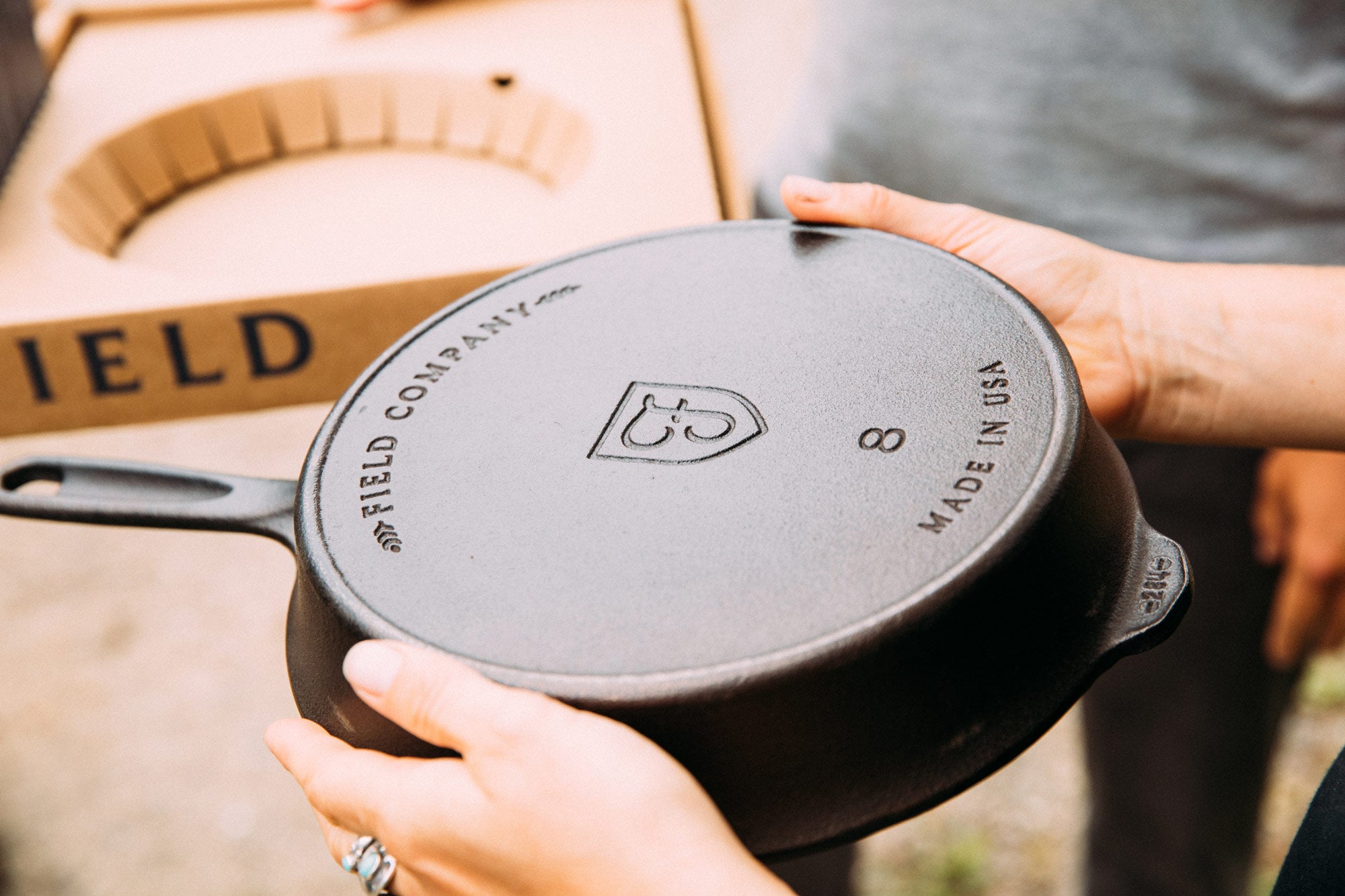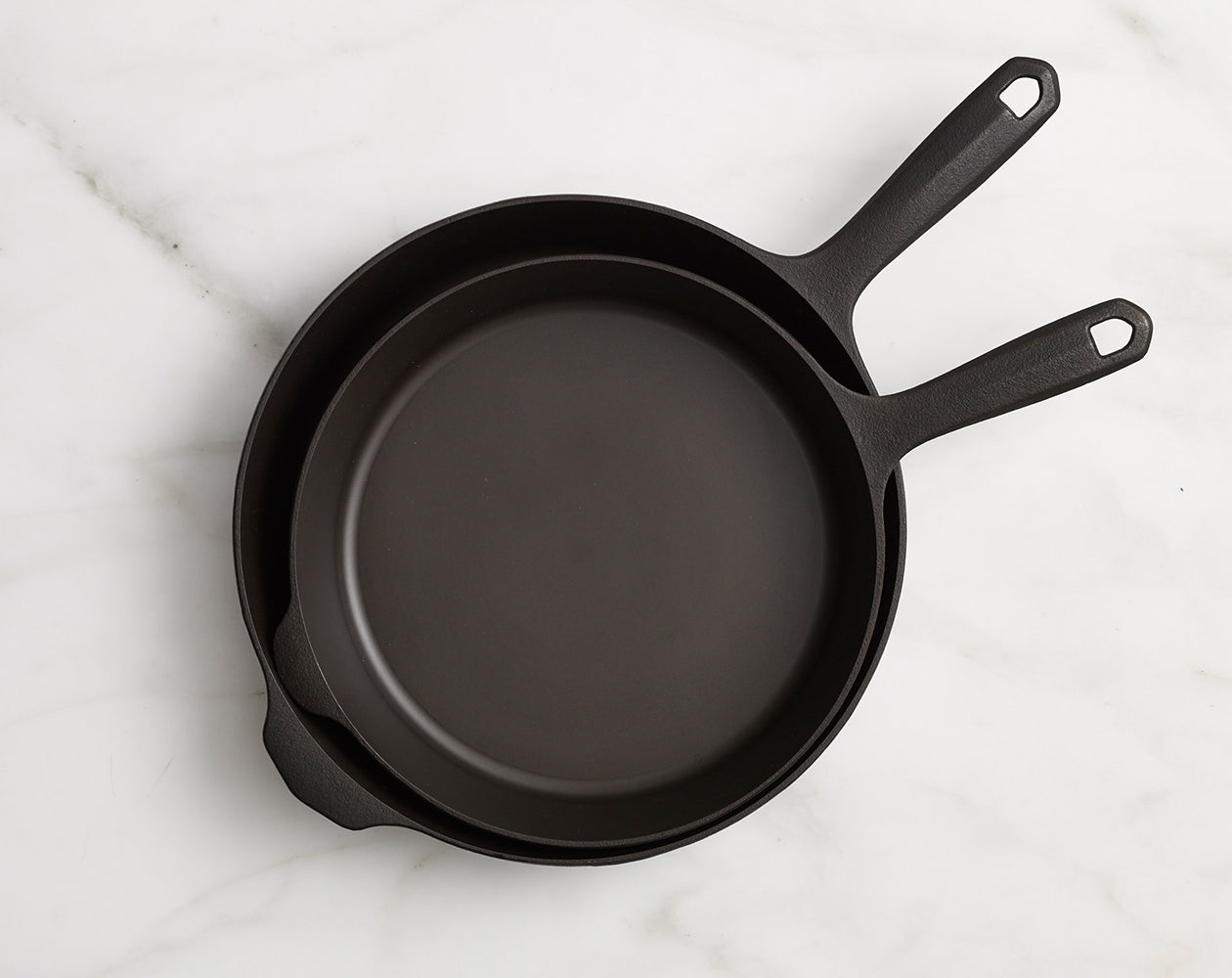
Table of Contents
- The benefits of cooking with a cast iron skillet
- What can you cook in a cast iron skillet?
- What should you not cook in cast iron?
- How can you tell if a cast iron skillet is good?
- How to choose the best cast iron skillet

The benefits of cooking in a cast iron skillet
Cast iron cookware has been around for centuries—and there’s a reason it’s so ubiquitously used in kitchens. Not only are cast iron skillets the secret to a perfect sear on steak (or, really, on anything), their versatility and naturally non-stick surface will quickly make them the one pan you use the most.
While some sources say cast iron’s greatest asset is even heating, that’s not necessarily true. In fact, the idea that cast iron heats evenly is a bit of a myth. Instead, cast iron skillets are so great because of their ability to retain heat. This means that once a cast iron pan is hot, it will maintain that high temperature much more easily than another skillet. When you’re doing high heat cooking, like searing a steak, the temperature of your pan will often drop when you add cold ingredients to it, making it harder to get that perfectly brown crust you’re looking for. With cast iron, this drop in temperature is minimal, yielding the best sear every time.

In addition to their high heat retention, cast iron skillets are ideal for everyday use because of their naturally nonstick surface. Unlike artificially nonstick pans, which rely on chemical coatings, a cast iron skillet simply becomes more nonstick as you continue using it, through a process called seasoning. When you heat oil in cast iron, it polymerizes and bonds with the surface of the pan. This thin layer of polymerized oil is called seasoning, and it’s what makes cast iron naturally non-stick. Over time, and as you use your cast iron pan often, it will develop more and more seasoning, making it even easier to use.
Besides its nonstick surface and ability to sear just about anything, cast iron is also the most useful cookware in your arsenal. A cast iron skillet can be used on a stovetop, in an oven or even over live fire. So whether you’re looking for something that’s great for campfire cooking, or if you want to cut down on the number of dishes you’re using each time you cook, a cast iron pan is the best option.
What can you cook in a cast iron skillet?
If you really want to take advantage of your cast iron, what should you be cooking in it? Since we’ve already delved a little bit into steak, lets start there:
Cast Iron Skillet Steak
When it comes to cooking steak, you want to get your pan as hot as possible, so you can develop a crunchy, well-browned crust. Since cast iron’s temperature doesn’t drop very much when you place a cold or room temperature steak in your skillet, this allows you to continue cultivating an even, thick crust. Furthermore, cast iron allows you to start by searing your steak on the stovetop, and then finish it off in the oven for a more even interior temperature, no need to switch pans. Grab our recipe for cooking cast iron steak in the oven here.
Cast Iron Skillet Pizza
The secret to a perfect pizza crust is a crispy, chewy exterior, with a soft, fluffy inside. If you don’t have a pizza stone, which can get up to soaring temperatures, then cast iron is your best bet for achieving the crispy pizza crust of your dreams. While everyone has their preferences, we’re partial to a Detroit-style pizza crust, especially if you’re cooking in cast iron. Adding your dough to a preheated pan is key to achieving a crunchy outside on your crust. Find our recipe for the best cast iron skillet pizza here.

Cast Iron Skillet Cornbread
Not only is a cast iron skillet great for baking cornbread, but baking cornbread is great for your cast iron skillet! The naturally butter cornbread will coat the surface and walls of your skillet with a thin layer of fat - as the cornbread cooks, this fat turns into seasoning. When you remove cornbread from your skillet, you’ll find that it slides out easily, and leaves behind a nice, even layer of new seasoning. (An added bonus: your cast iron skillet will give your cornbread a perfectly crispy crust!)

What should you not cook in cast iron?
While there is very little you can’t cook in your cast iron skillet, there are a few precautions you should take, and ingredients to avoid. It’s a common myth that you shouldn’t cook acidic foods in cast iron. The seasoning on cast iron is constantly changing; when you bake something like cornbread, you’re adding to the seasoning. When you make a tomato sauce in your pan, you’ll likely lose a little seasoning, but that’s okay! It’s normal to lose seasoning from time to time; what’s most important is that you make sure you have enough seasoning built up before you cook something acidic. If you don’t have seasoning already built up, then you risk bringing your pan back to bare metal. And if you lose a little more seasoning than you’d like when cooking acidic dishes, then all you have to do is cook some dishes that will be easier on your pan—such as sautéed and roasted vegetables, or anything fried. You can find our guide to cooking acidic foods in cast iron here.
The only other caveat for cast iron is a little more obvious: Because of size limitations, we don’t recommend making a soup or stew in your skillet. There are some dishes that are a little more suited for a pot, and this is one of them. However, a cast iron Dutch oven would be great for a hearty stew!

How can you tell if a cast iron skillet is good?
When searching for the perfect cast iron skillet, there are a few key attributes to keep an eye out for. First and foremost is size: What are you going to be cooking the most? Is this pan the appropriate size for that? While a big skillet may be great for frying chicken, it’s not always the most versatile for everyday use. For this reason, we typically recommend having a selection of a few different sizes; owning multiple sizes of skillet can also allow you to make dishes that require two pans, like a spatchcocked chicken. If you plan on making dishes with a bit more volume, then you might need a cast iron Dutch oven. Just figure out what sizes and dimensions work best for you!

Since cast iron is something you use every day, it’s important to buy a pan that you can use easily—this means you want a skillet that still has the heft of cast iron, without being too heavy. Most modern cast iron is heavy and rough, especially when compared with vintage skillets. This can become a nuisance when you’re using your pan every day, bringing your skillet on a camping trip, or moving it frequently from the stovetop to oven. We recommend looking for the lightest skillet you can find, so you don’t have to sacrifice comfort for cast iron cooking.
Perhaps most critically, you want to find a skillet that’s easy to care for. If you buy a skillet with a rough surface, it’ll be harder to build up a nice, even layer of seasoning; this means food might stick more easily, your skillet could be harder to clean and you’ll likely have to season your pan a little more often. Instead, you should look for a pan with a smooth, even surface: these skillets typically require a little more hand-crafted effort in their production, but that effort pays off when you get a pan that makes care and cleaning easy.

Finally, the best cast iron skillets come with a layer of two (or more) of seasoning. Factory seasoning allows you to begin cooking with your skillet as soon as you get it. No oven seasoning is needed, and your pan will reach that non-stick, bulletproof level of seasoning you’re looking for much more quickly. You should also take note of what kind of oil is used to pre-season your pan. Not all oils are created equally; we recommend looking for a pan pre-seasoned with grapeseed oil, thanks to its high polyunsaturated fat content.
How to choose the best cast iron skillet
Cast iron will last a lifetime (and beyond), so make sure you choose your pan wisely. You’re looking for a pan that has all of the above qualities (appropriate size, weight and seasoning), and also has the design that works best for you. Does it feel good in your hand? Is it the right size for your stove top burner? When you’re buying something that will last a long time, you don’t want to skimp on quality; this is why details like a smooth surface and light weight matter. But this doesn’t mean you need a pan with extra add-ons or accessories; too many bells and whistles can distract from true quality, and make a skillet more difficult to use. A great example of this is a pour spout: While many skillets have one, we’ve found that they simply don’t work! By eliminating a feature that didn’t do its job, we streamlined the design of our skillets.

There are a few other considerations worth keeping in mind when choosing the best cast iron skillet; like all items that you’ll use regularly in your home, it’s nice to know where your pan is made. We make all of our pans in the USA, using only recycled iron sourced from American vendors, because we like to know exactly where, how and by whom our pans are crafted. We also recommend taking a look at the reviews for a pan before you buy it; if everyone else is loving a skillet, then it’s much more likely you will too. Scroll to the bottom of this page to find some of the rave reviews for our pans.
If you’re looking for a skillet that’s the right size for flipping pancakes or frying chicken, we’d recommend our No.12 Field Skillet. Want a pan that you can fry two eggs in every day? Then you probably need the No.6 Skillet. If you’re new to cast iron, and need a variety of sizes, then a a cast iron cookware set of a few pans. But if you’re not set on a certain size or skillet, feel free to shop around! You might be surprised at which pan catches your eye, or what you never realized you need.



